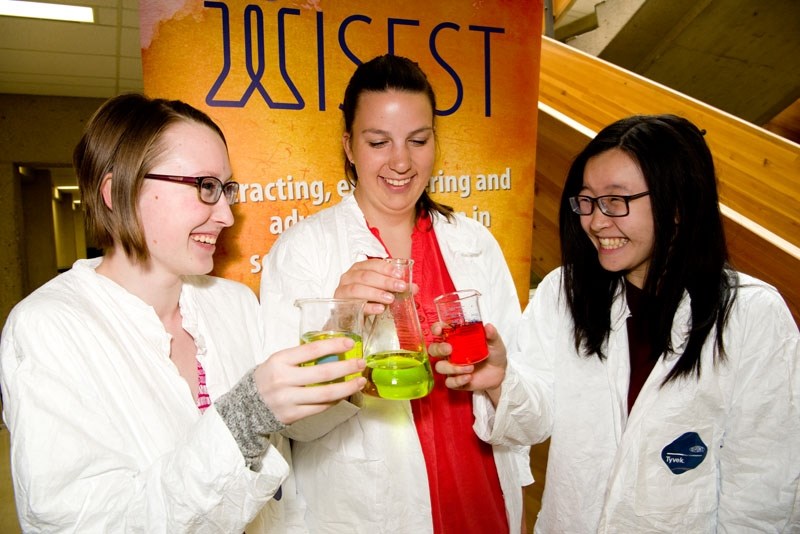Sara Kluthe spent her summer watching rats on TV.
Alyssa Wong taught a computer to play a board game.
And Caroline Part? She got to scoop rat brains with a spoon.
You cut off the top of the rat's skull with scissors and use a long, flat spoon to get the brains, said Part, who is headed into Grade 12 this fall at Bellerose.
"Its about the size, I'd say, of a walnut," she said, and grey in colour.
Kluthe, Wong and Part are part of the Women in Scholarship, Engineering, Science and Technology (WISEST) Summer Research Program at the University of Alberta. They've spent the last six weeks doing hands-on scientific research at the U of A as part of an effort to bring more women into science and engineering.
Researchers have known for years that women are underrepresented in the science, engineering, technology and mathematics fields. A 2013 Statistics Canada study found that women represented just 39 per cent of the university graduates aged 25 to 34 in these areas.
"Diversity spurs innovation," said WISEST co-ordinator Fervone Goings, and if all your scientists are the same gender, you don't innovate.
The WISEST summer program gives young men and women in Grade 11 a six-week paid job at the U of A doing actual scientific research in fields where their gender is underrepresented, Goings said – science, engineering and technology for females, and nursing, human ecology and nutrition for males. Some 39 girls and two boys went through this year's program.
Igors! Fetch the brains!
Sara Kluthe of Morinville Community High School got to use Nile River rats to study the effects of Type 2 diabetes on people.
"It's kind of like a really big mouse," she said of the brown rodents. These rats were used because their eyes were closer to human eyes structurally than those found in Norway rats (which are the typical lab rats).
Type 2 diabetes contributes to glaucoma, cataracts and other vision problems in humans, Kluthe said. To study these issues, she and her fellow researchers fed rats fatty foods to give them Type 2 diabetes and then filmed them watching a screen with moving bars on it.
"If you were driving in a car and you saw a tree go by, your head would kind of follow it," she explained. By tracking how the rats moved their heads to track the bars and slowly reducing the bars' visibility, Kluthe's team hoped to track the effect of diabetes on visual acuity.
Surprisingly, the diabetic rats appeared to be better, not worse, at tracking the bars than the healthy ones, "which was kind of weird," Kluthe said. Their current theory is that the test isn't sensitive enough to detect difference in the rats' eyesight.
Once their experiment was over, many of the rats were killed and handed over to Part's team for neurological experiments related to diabetes. It was Part's job to collect the brains, faeces, intestinal contents, footpads and nerve endings of the rats.
This involved squeezing out their gut contents using scissors, Part said.
"It's actually not that bad," she said of the experience.
"I just don't think about it. It's all for science."
Part also got to use fluorescent dyes to detect differences in the nerve tissues of diabetic and regular rats. It's early days for this research, but she said she spotted a definite difference in the number of nerve fibres associated with pain and touch in the two types of rat.
Wong, who attends Paul Kane, spent her time coming up with a better way for computers to play the board game Hex – a game where two players lay hexagonal pieces to connect two sides of a board while preventing their opponent from doing the same.
Hex is simple to learn but hard to master, she continued. Programmers have yet to figure out a good way to teach it to computers.
"With current algorithms, even solving a 10-by-10 board will take thousands of years," she said, referring to a condition where a computer can accurately predict the outcome of a game from any board state. By making computers better at these games, engineers can create smarter computers.
Wong said she spent most of her time learning to code and surveying people on how they would solve various puzzles. She's learned a lot about coding and is now a big fan of Hex.
"I was essentially playing games all summer."
Kluthe said it's important to have a balance of genders in all fields of work.
"I don't think your gender should really determine where your passion lies," Part added.
"You should be able to study or research whatever you want."
Part said her time in the WISEST program helped her decide to pursue a career in research.
"You learn so much in so little time it's unbelievable," she said.
"Where (else) are you ever going to get such an experience?"
The summer program wraps up Tuesday with a public presentation of the students' work at the U of A's Centennial Centre for Interdisciplinary Science. Email [email protected] for details.




